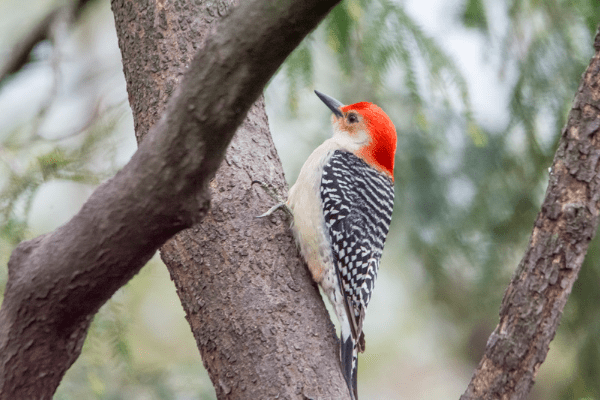Contents
- How To Identify Woodpeckers
- How To Attract Woodpeckers To Your Yard
- FAQ Questions About Woodpeckers
- Migration
- How many species are there throughout the globe?
- Where do they live?
- Do they all live in trees?
- What is their lifespan?
- How big do woodpeckers get?
- What are the most common colors of woodpeckers?
- How do woodpeckers “peck” so much?
- How do the birds get food out of their hole?
- How do they communicate?
- What do woodpeckers usually eat?
- How much does a woodpecker peck?
- Woodpecker Behavior And Migration Patterns
- Woodpecker Facts
- Woodpeckers Have Impressively Long Tongues
- Woodpeckers Can Cling To Trees
- Woodpeckers Have Furry Noses
- Woodpeckers Do Not Get Headaches
- Woodpeckers Like Their Nests To Be Perfect
- Woodpeckers Are Music-Makers
- They Prefer To Stay Vertically
- Woodpeckers Are Fond Of Nuts
- Woodpeckers Like New Holes
- Woodpecker Variety
- Woodpeckers Can Peck 20 Times Per Second
- Greatest Threat To The Woodpecker
- Woody The Woodpecker
When you hear the familiar sound of drilling and drumming, it’s safe to say a woodpecker is in your area. These unique, pretty birds are fun to spot. There are many different species, so it’s neat to learn all of the identifying traits about them. In this article, we discuss all you need to know about woodpeckers.
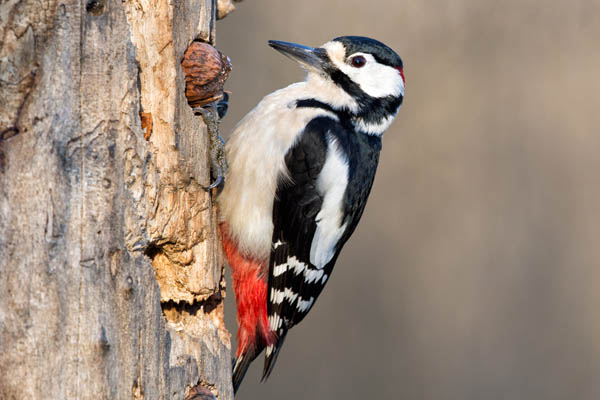
How To Identify Woodpeckers
These sweet flyers can be identified in a few different ways. A woodpecker’s identity can usually be found by looking at special markings, their upright posture, and their clinging to a tree trunk or branch. Identifying a specific species depends on the size, plumage, markings, bill, and wings. They will also have a distinct habitat, type of hole, and sound. Below you will find some of the most popular species of woodpeckers in North America.
Downy woodpecker

The Downy woodpecker is the smallest of its type in North America. It can be found throughout the year in the US and southern Canada. It stands about seven inches long. They are most often found in forests, parks, and urban areas. This type of woodpecker has a straight but short bill with broad shoulders. One characteristic of a Downy woodpecker is that its back is always straight while leaning away from the tree’s trunk.
Hairy woodpecker
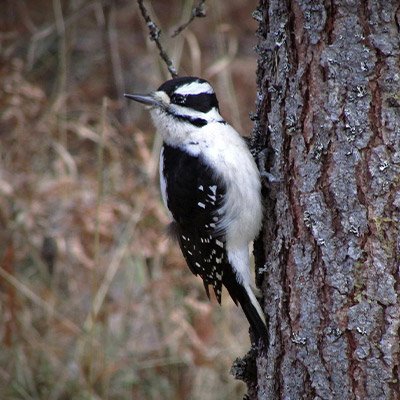
A Hairy woodpecker looks very similar to the Downy woodpecker listed above. However, one noticeable difference is that its beak is significantly longer than the Downy woodpecker. It has a dash of color along the crown of the head. You can find this species of woodpecker foraging among the tree trunks and main branches of trees.
Red-headed woodpecker
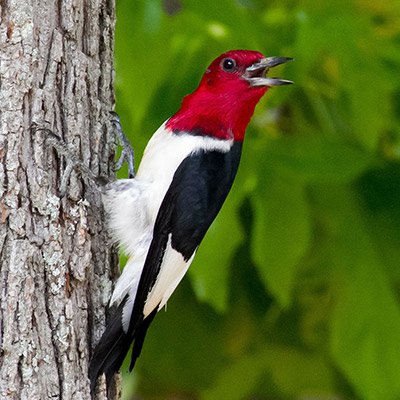
The Red-headed woodpecker is commonly found in the eastern US throughout the year. They are not just red-headed but also have white and a blue-black coloration. They have white patches on the wings. The bright red along their head is also found along their throat. This type of woodpecker is unique amongst its kind because, unlike other woodpeckers, it stores food and covers it.
Red-bellied woodpecker
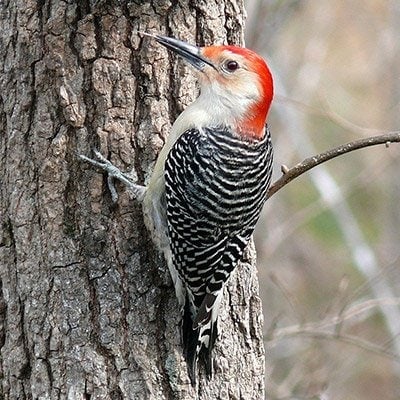
The Red-bellied woodpecker is one that enjoys coming right into your hand for a treat. This woodpecker doesn’t have a bright red belly, but really just a “blushing” belly. It can be tough to figure out if it’s even a red-bellied species, but the mane and the belly are both a little red. These woodpeckers are commonly found throughout the eastern United States in swamps and riverside woods.
Ladder-backed woodpecker
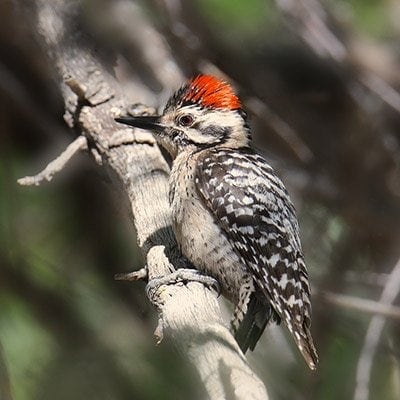
The Ladder-backed woodpecker is a desert dweller and hangs out for the entire year in the southwestern US and Mexico. The males have a red tint along the crown. The females lack the red tint but are usually black, white, and gray. The underparts of these birds usually have spots. The tail is usually solid black. It has a striking bold black and white barring on the back and wings.
Lewis’s woodpecker
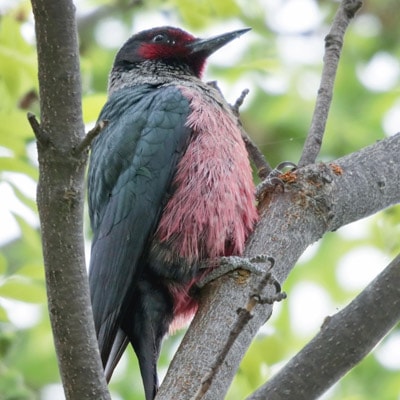
The Lewis’s woodpecker is one of the larger woodpeckers and can be typically found in open pine woodlands throughout the western portion of the United States. These creatures are different than other woodpecker species, as they are notorious for catching insects mid-flight. They are a dark glossy green in color, with a dark red face, a gray collar, and a noticeable pink wash on their belly.
Golden-fronted woodpecker
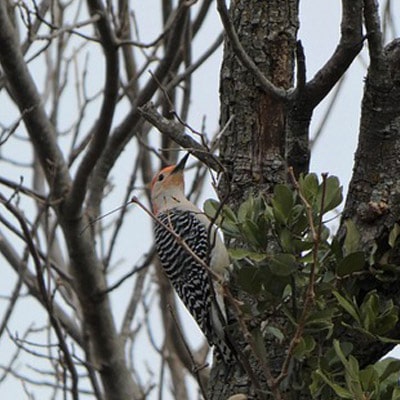
The Golden-fronted woodpecker is a medium-sized North American woodpecker commonly found in open woodlands. They look quite similar to the Red-bellied woodpecker, having black-and-white barred wings, grayish-brown heads and bodies, and black tails. However, they have golden napes and nasal tufts, which is where they get their name came from.
Red-cockaded woodpecker
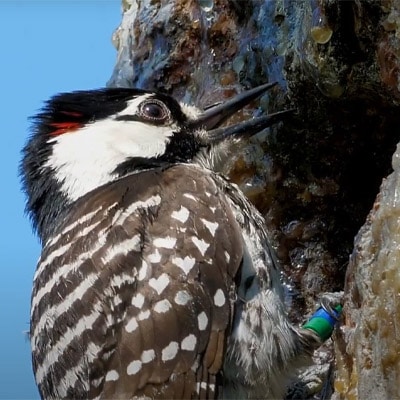
You can find the Red-cockaded woodpecker in the southeastern portion of the United States. It lives exclusively in pine trees, particularly those that are infected with red heart fungus. This fungus softens the wood, making it easier for the woodpecker to dig cavities. These interesting creatures live in family groups with helpers. Unfortunately, they have been listed as endangered since 1970 due to habitat destruction.
American three-toed woodpecker
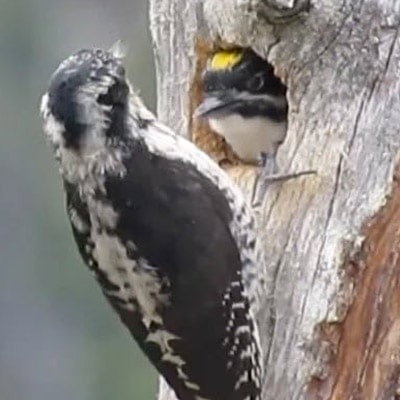
The American three-toed woodpecker is a small, relatively quiet woodpecker. These species of woodpecker are found in the western and northern coniferous forests. They are larger than a Downy woodpecker but smaller than the Hairy woodpecker species. Males have a characteristic yellow patch on their foreheads. Both males and females have varied barred black and white back and flanks, giving them a “messier” appearance than most other woodpecker species.
Black-backed woodpecker
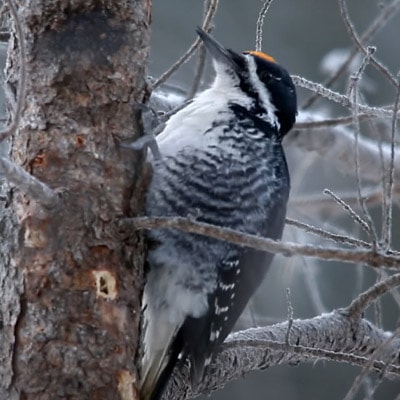
The Black-backed woodpecker, also called the Arctic three-toed woodpecker, is a medium-sized woodpecker that is considered generally uncommon. However, it is not so quiet or unobtrusive as the American three-toed woodpecker. You can identify this species of woodpecker by its solid black back, barred flanks, and a single white stripe on its face. Male Black-backed woodpeckers are distinguished by their yellow crown patch.
Northern flicker

The Northern flicker can be found throughout North America and easily identified by its clean and neat-looking appearance. They have long heads and downward curved bills. Interestingly enough, this is one of the few woodpecker species that migrate. Also, unlike other woodpecker species, they tend to hunt for food, such as ants and beetles, on the ground.
There are two variations of Northern flickers – Yellow-shafted and Red-shafted. Yellow-shafted flickers are found on the eastern portion of the United States, whereas, Red-shafted flickers are found in the west. Outside of location, you can tell the two apart by looking at the color of the large feathers that make up the wings and tail. This woodpecker is a favorite among birders as it is known for its peaceful expression and beautiful plumage.
Red-naped sapsucker
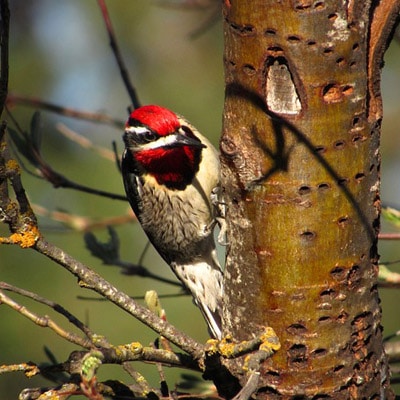
The Red-naped sapsucker is a medium-sized woodpecker that resides in western North America, particularly in the Rocky Mountain and Great Basin regions . It has a slight peak to the back of the head with a very pointed bill. It is easily confused with Downy and Hairy Woodpeckers. However, it has a solid white patch on its wings that will help you distinguish it from the others. They climb up and downs trees with ease, using their tails for support.
Yellow-bellied sapsucker
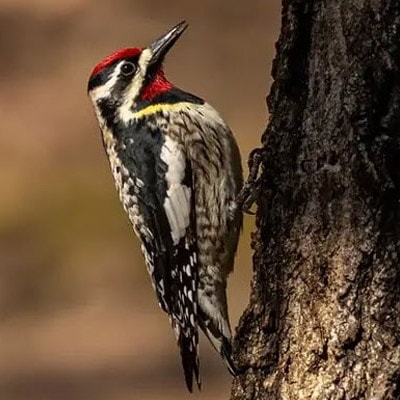
The Yellow-bellied sapsucker is a woodpecker that you won’t typically find at your birdfeeder but you might be able to entice them to eat from your suet feeder. They are located throughout eastern North America and are one of the few woodpecker species from this region that is completely migratory.
If you take a walk through the forest, look for rows of shallow holes in the tree bark. This is how they leave their mark. They use their brush-tipped tongue to lap up leaking sap and any insects that are trapped in it. Yellow-bellied sapsuckers aren’t picky eaters and have been found to drill sapwells in over 1,000 species of different trees and wooded plants. However, if it were up to them, they might choose a birch and maple tree over other types.
Another interesting fact about these beauties is that the sapwells that they make attract hummingbirds, who also feed off the sap from the tree. In fact, in some parts of Canada, Ruby-throated Hummingbirds time their migration with the arrival of Yellow-bellied sapsuckers.
Pileated woodpecker

The Pileated woodpecker is now considered the largest of all woodpecker species, only coming second to the Ivory-billed woodpecker. Unfortunately, the Ivory-billed woodpecker is now considered “lost” because, according to federal officials, there is “no objective evidence” of its continued existence.
Most birders will argue that the Pileated woodpecker is one of the most striking forest birds in the North American continent. They aren’t very quiet and you can easily hear them whacking at dead trees and fallen logs while searching for their primary source of food, carpenter ants. You can tell if one has been around because they leave unique rectangular holes in the wood. Thier nest holes are used by other opportunistic species, such as ducks, owls, swifts, pine martens and even bats.
How To Attract Woodpeckers To Your Yard
Woodpeckers are usually pretty happy nestled on their tree. They chisel the day away, so it can be tough to get them to come to your yard. The easiest way to attract them is to offer them food.
The most common types of trees where woodpeckers like to hang out are spruce, fruit, sweet gums, and pine trees. They love trees with softer wood to make it easier for them to find insects. They’ll drill into a tree with bark lice insects or wood borers to find their next meal. They also like bushes that produce fruits or berries. These include apples, dogwood, tupelo, mulberry, and elderberries.
Make A Place To Perch
It’s best to provide a woodpecker feeder that includes a tail prop. Most species have zygodactyl feet, so they have two back and front toes. This helps them grip their favorite trees in a vertical position. A tail prop will help the bird get the best grip so it can hang in a vertical position.
Treats They Love
Woodpeckers aren’t too picky when it comes to eating. They love nuts, berries, tree sap, and worms. They will also eat acorns and sunflower seeds. You can even lure some with fruit like grapes and apples. Their favorite thing might be suet. This is a formula bird food made of animal fat and other ingredients. It gives them a quick boost of energy. It’s a bit of a substitute for insects. It’s best to offer this in a wire cage so you only have to refill it once a week.
Make A Special Feeder
Woodpeckers need a special upright feeder. This will help their feeding posture. You can use a hanging hopper feeder, which is a special suet plug feeder. You should place these feeders near trees so they can naturally go from their tree to feeding on your feeder. Some woodpeckers will feast on your hummingbird feeder’s sugar water. If they enjoy feeding here, make sure this feeder has large ports for their big beak.
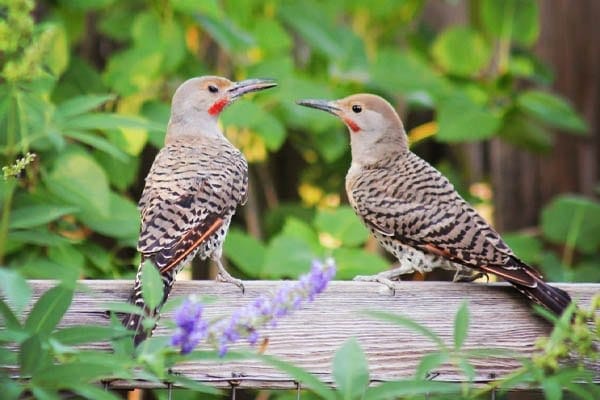
FAQ Questions About Woodpeckers
The average lifespan is from 4 to 12 years in the wild, depending on the species.
The two largest woodpeckers in the world are the imperial woodpecker and the ivory-billed woodpecker, both are critically endangered. The largest confirmed woodpecker is the great slaty woodpecker (Mulleripicus pulverulentus) at 48–58 centimeters (19–23 inches) long and a weight of 360–563 grams (0.794–1.241 lb).
Migration
Woodpeckers are colorful and beautiful birds, well-known for pecking the wood of trees with their pointed beaks.
How many species are there throughout the globe?
These beautiful birds make up about 200 different species.
Where do they live?
Woodpeckers live in almost every area of the globe. The only place they don’t reside is in New Zealand, New Guinea, Madagascar, and Australia.
Do they all live in trees?
Most of the species can be found in the woods or forests on trees. Some are known to actually live in deserts and rocky hillsides.
What is their lifespan?
A woodpecker will usually live from four to 12 years, depending on its species.
How big do woodpeckers get?
The largest woodpecker alive is the great salty woodpecker. It is about 19–23 inches long. The other largest two species are thought to be extinct. These are the imperial woodpecker and the ivory-billed woodpecker.
What are the most common colors of woodpeckers?
The most common colors of species include red, yellow, black, and white. Some do have orange, gold, and brown. The brighter colors are often found in patches along their head, neck, or back.
How do woodpeckers “peck” so much?
These strong birds have tough bills made for drilling holes. They also have long tongues that are sticky just for extracting food.
How do the birds get food out of their hole?
This sticky tongue is about four inches long. It’s usually barbed so it makes it easier to extract bugs and sap from holes in the trees. When not using its tongue, a woodpecker will wrap it around the back of its head.
How do they communicate?
Most birds sing, but woodpeckers don’t communicate this way. They do chirp and talk, but mainly, they drum on objects. Anything that echoes loudly is the perfect way to communicate for these birds. They drum to attract their mate and establish their territories.
What do woodpeckers usually eat?
Woodpeckers love all kinds of nuts and fruit. They will also eat insects and worms in their trees. They even eat the sap from live trees. Many people love the fact that these birds like to dine on their insects, so they keep bugs away.
How much does a woodpecker peck?
These birds are able to peck 20 times per second. They can usually peck about 10,000 to 12,000 pecks per day.
Woodpecker Behavior And Migration Patterns
Not all woodpecker species fly south for the winter but are found to stay year-round in the region. They nest in these areas by chiseling roosting cavities in the trees. These are little hollows where they can take shelter during the cooler nights of the year. The Red-headed Woodpecker is one species that does follow a regular migratory pattern. It moves to where it can find pecans, acorns, and beechnuts in the cooler months. This is usually in its breeding range in neighboring states.
Woodpeckers are a unique, beautiful bird that bird watchers enjoy spotting. They’re easy to spot when you can hear their pecking, but it’s even more interesting to spot when you see their gorgeous marks. Look for them in your local wooded areas today.
Woodpecker Facts
Woodpeckers Have Impressively Long Tongues
The woodpecker’s tongue can be twice the size of their bill. This way, they can reach for insects inside of the holes that they are pecking at. When they are not using their tongue for catching insects, their tongue will curl around the back of their head, in between their skull and their skin. Their long tongue is sticky and it can also be barbed to help pull the insects out from holes.
Woodpeckers Can Cling To Trees
The woodpeckers have strong tail feathers. This helps them hold them up on a tree trunk. Furthermore, they have two front toes and two back toes (zygodactyl feet), giving them more support.
Woodpeckers Have Furry Noses
If you look closely at a woodpecker, you will notice that they have furry noses. However, their feathered-covered noses serve an important purpose. It helps keeps the dust and splinters out of their nose while they peck on wood.
Woodpeckers Do Not Get Headaches
You would think that with all that head-banging, the woodpecker would feel the impact of their pecking on wood. However, the design of the woodpecker’s bill helps distribute the shock throughout their skull, which is incredibly thick.
Woodpeckers Like Their Nests To Be Perfect
These perfectionists nest in tree cavities. They carve out the access hole themselves. If you see a woodpecker’s nest, you will notice that the entryway is carved into a perfect circle.
Woodpeckers Are Music-Makers
Most animals tend to make sounds with their own bodies. However, the woodpecker is one of the only animals in the animal kingdom that will use a variety of objects to produce sound. They will drum on metal, wood, and other objects as a means to attract a mate, locate food or establish territory.
They Prefer To Stay Vertically
When a woodpecker climbs down a tree, they will stay upright, meaning that they lower themselves by leading with their tail. Most insect-eating birds will crawl down a tree head-first. Experts claim that this allows the woodpecker to find more insects since they can access the tree differently.
Woodpeckers Are Fond Of Nuts
Not only do woodpeckers eat insects, but they are quite particular to nuts and berries. For those who love to attract woodpeckers to their yard, this makes it easy as you can set up a nut feeder to lure them to your yard.
Woodpeckers Like New Holes
Each year, the woodpecker will create a new hole to house in. Other bird species take advantage of this and use a woodpecker’s abandoned hole.
Woodpecker Variety
Scientists have found that there are more than 180 woodpecker species throughout the world. They are adapted to different habitats that include deserts, forests, jungles, and more urban settings. Interestingly enough, woodpeckers are not found in Antarctica, Australia, Madagascar, or New Zealand.
Woodpeckers Can Peck 20 Times Per Second
When the woodpecker is feeding, excavating a nest, or drumming, the woodpecker will peck about 20 times per second. In a day, the woodpecker pecks 8,000-12,00o times, on average.
Greatest Threat To The Woodpecker
The woodpecker’s greatest threat is habitat loss. Habitat loss is due to urban development and urban sprawl. Furthermore, the use of insecticides eliminates vital food sources that the woodpecker depends on. Other threats include forest fires that reduce a habitat that the woodpecker needs to survive.
Woody The Woodpecker

The most famous woodpecker is, of course, Woody The Woodpecker, which was created in 1940 by Ben “Bugs” Hardaway. As popular as this woodpecker is, however, he is not a distinct species of woodpecker. He has a red head, blue wings and back, and a white underside, possibly an inspiration of the red-headed woodpecker. However, his size is much closer to a pileated woodpecker.

